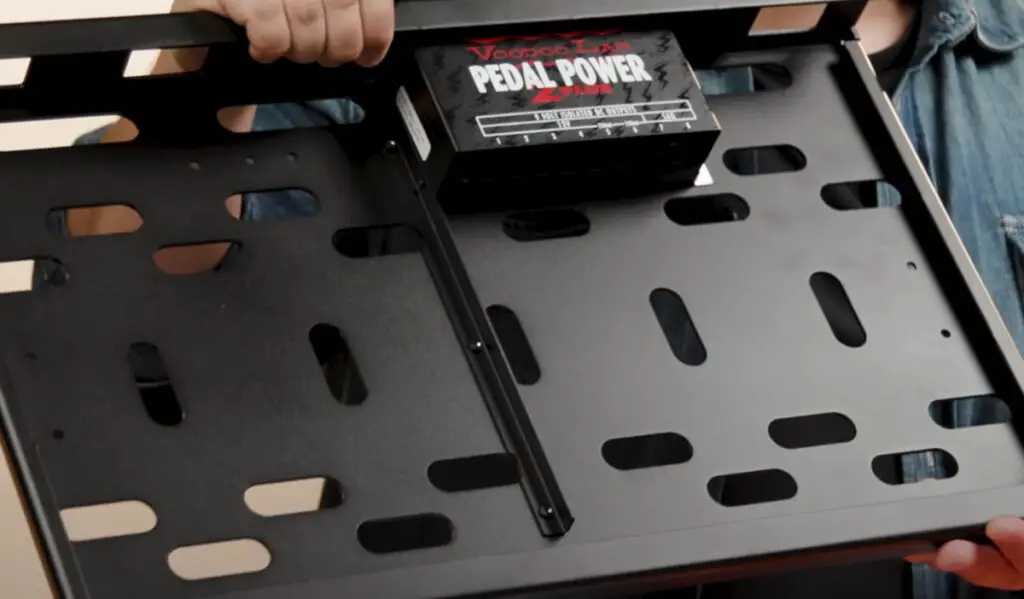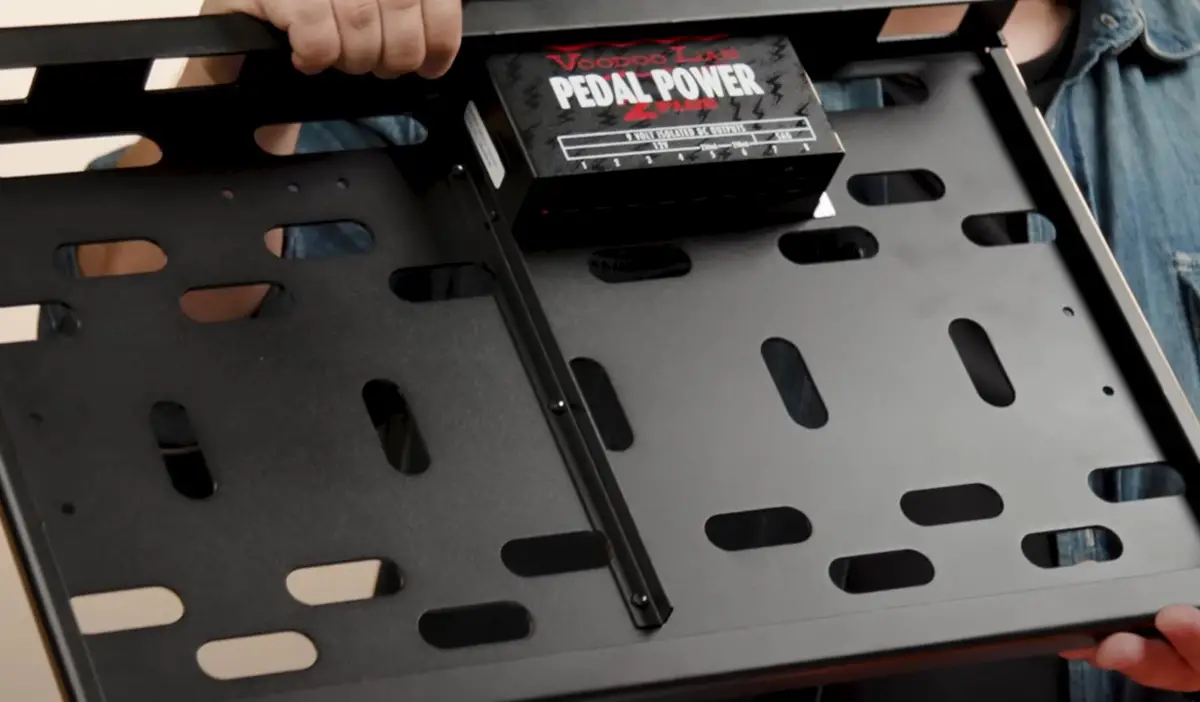Navigating the world of guitar pedals can be a thrilling journey. The array of sounds and effects at your fingertips can truly transform your music-making experience. However, managing these devices – particularly their power requirements – can be a bit daunting, especially when you’re dealing with multiple pedals on a pedalboard.
For starters, what is a powered pedalboard?
A powered pedalboard is a pedalboard that comes with an integrated power supply designed to power all the pedals mounted on it. This provides a streamlined setup, eliminating the need for a separate power supply and simplifying cable management.
In this comprehensive guide, we’ll demystify the process of powering your pedalboard. We’ll walk you through the various power supply options available, discuss the typical power requirements of pedals, and even delve into the concept of a powered pedalboard. Whether you’re a beginner just starting to build your pedal collection or a seasoned pro looking to optimize your pedalboard, this guide will equip you with the knowledge you need to ensure your pedals are powered correctly and efficiently. Let’s plug in and get started!

How Do You Power Pedals On A Pedalboard?
There are several ways to power pedals on a pedalboard, and which one you use depends on the types of pedals you’re using and your own personal setup. Here are some of the common methods:
- Individual power adapters: This is the simplest method, where each pedal has its own individual power adapter. The downside to this method is that it can lead to a mess of wires and take up a lot of power outlets.
- Daisy chain: A daisy chain is a power supply cable that connects multiple pedals together. One end of the daisy chain plugs into a power adapter, and the other end has multiple plugs for connecting to the pedals. This method is more organized than using individual power adapters, but it can cause problems if the pedals require different voltages or if there’s too much current draw for the power adapter to handle.
- Power supply units (PSUs): A PSU is a device that plugs into a power outlet and provides power to multiple pedals at once. PSUs can provide consistent power to each pedal, can accommodate different voltage requirements, and can help to reduce noise that can be caused by power issues. However, they can be more expensive than other methods.
- Battery power: Some pedals can be powered by batteries. This can be useful for portable setups, but batteries can be expensive to replace and aren’t as reliable as other power sources.
It’s important to note that different pedals may require different voltages, and providing too much or too little power can damage the pedals. Check the power requirements of your pedals before connecting them to a power source.
Also, note that using a power source with isolated outputs can help to reduce noise. In a power source with isolated outputs, each output has its own separate ground, which can prevent ground loop noise. This is often a feature of higher-end PSUs.
When arranging your pedalboard, try to keep power cables and audio cables separate to minimize interference. Also, consider using power cables with right-angle connectors to save space and keep your setup tidy.
What Power Supply Do I Need For a Pedalboard?
The type of power supply you need for your pedalboard depends on a number of factors including the number of pedals you have, the power requirements of those pedals, and your budget. Here are some key factors to consider:
- Number of Outputs: Consider how many pedals you have on your board. Each pedal will need its own output on the power supply.
- Voltage Requirements: Different pedals require different voltages. Most pedals run on 9V, but some may require 12V, 18V, or even 24V. Check the specifications for each of your pedals to ensure the power supply you choose can provide the needed voltages.
- Current Draw: Pedals also have different current requirements. Most analog pedals have a low current draw (below 100mA), but some digital pedals can require much more (200mA to 500mA or more). Make sure your power supply can deliver the required current to each pedal.
- Isolated Outputs: Power supplies with isolated outputs are usually preferred. With isolated outputs, each output has its own separate ground, which can prevent ground loop noise and interference between pedals.
- Size and Mounting: Consider the size of the power supply and make sure it will fit under or on your pedalboard. Some power supplies are designed to be mounted underneath certain pedalboards.
- Budget: Power supplies can range from affordable to quite expensive, depending on the features they offer. More expensive power supplies often have features like isolated outputs, more outputs, or the ability to handle more voltage and current variations.
Some popular power supplies among musicians include the Voodoo Lab Pedal Power 2 Plus, the Truetone 1 SPOT Pro, and the Strymon Zuma, among others. These power supplies are well-regarded because they offer a range of voltages, isolated outputs, and high current capabilities, which can accommodate a wide variety of pedals.
Remember to check the specifications of your pedals and the power supply before making a purchase to ensure compatibility.
Are Most Guitar Pedals 9V?
The majority of guitar pedals are designed to operate on 9 volts (9V). This has become something of a standard in the industry, particularly for pedals that come in the common “stompbox” format.
However, it’s important to note that not all pedals use 9V. Some pedals, particularly certain digital pedals or larger multi-effects units, might require 12V, 18V, or even 24V. Also, some vintage or boutique pedals might have unusual power requirements.
Check the power requirements of each individual pedal before plugging it into a power source.
Providing too much voltage to a pedal can potentially damage it, and providing too little voltage might result in the pedal not functioning correctly. Also, check the current requirements of your pedals, as some pedals may require more current (measured in milliamperes, or mA) than others.
Using a power supply that allows you to select the voltage for each output can be a good way to accommodate pedals with different voltage requirements. Alternatively, some power supplies provide a mix of 9V, 12V, and 18V outputs.
What Is a Powered Pedalboard?
A powered pedalboard is a pedalboard that comes with a built-in power supply. This integrated power supply is designed to power all the pedals that you mount on the board.
The advantage of a powered pedalboard is that it offers a more streamlined and clean setup, as you don’t need to worry about purchasing and installing a separate power supply. Everything you need to power your pedals is already included, which can also simplify cable management and make setup and tear down quicker and easier.
Typically, these power supplies will have multiple outputs for powering a variety of pedals, and they may offer different voltage options (like 9V, 12V, or 18V) to accommodate different types of pedals.
However, there are some considerations to keep in mind. One is that you need to ensure that the built-in power supply can meet the power requirements (in terms of both voltage and current) of all your pedals. Also, consider pedals you plan on buying in the future.
Another is that the quality and features of the power supply can vary from one model of powered pedalboard to another. Some might offer isolated outputs (which can reduce noise), while others might not.
Some examples of powered pedalboards include models from companies like Pedaltrain, Voodoo Lab, and SKB. As I’ve said, it’s a good idea to research different options and consider your specific needs when choosing a pedalboard.
How Much Power Does a Pedalboard Use?
The power consumption of a pedalboard can vary greatly depending on the number of pedals you have and the specific power requirements of each pedal.
Most analog guitar pedals, such as distortion, overdrive, and chorus pedals, typically draw anywhere from 5mA to 20mA of current at 9V. Digital pedals, like delay, reverb, or multi-effects units, can draw significantly more current, often between 50mA and 500mA. Some particularly complex digital pedals might even draw up to 1A (1000mA) or more.
To calculate the total power consumption of your pedalboard, you would need to add up the current draw of all your pedals.
For example, if you have a pedalboard with five analog pedals that each draws 10mA and one digital pedal that draws 100mA, the total current draw would be 50mA + 100mA = 150mA.
Keep in mind that this is a rough estimation, as the actual power consumption can vary based on how hard you’re driving the pedals, whether the pedals have LED indicators and other factors.
Also, remember that it’s important to make sure your power supply can provide enough current for all your pedals. If your total current draw is 150mA, for example, you would need a power supply that can provide at least that much current.
And if your pedals require different voltages, you’ll need a power supply that can accommodate those voltages as well.
Here’s a simple table format that you can use to organize and understand the power requirements of your pedals:
| Pedal Name | Voltage Requirement | Current Draw |
| Pedal 1 | 9V | 10mA |
| Pedal 2 | 9V | 20mA |
| Pedal 3 | 12V | 100mA |
| … | … | … |
| Total | {Sum} mA |
Copy this table into a spreadsheet. You can fill in the name of each pedal, its voltage requirement, and its current draw in the respective columns. The total current draw at the bottom of the table gives you an idea of the minimum current capacity your power supply should have.
Let me know if you would find it useful for me to provide a spreadsheet that auto-calculates.
If you’re using a power supply with multiple outputs, you could expand this table to also include which output each pedal is connected to. This could be especially useful if your power supply has outputs with different voltages or current capacities.
Conclusion
Understanding the power requirements of your pedalboard is crucial to maintaining the performance and longevity of your pedals. While it may seem complex at first, with some basic knowledge and careful planning, you can easily manage the power needs of your pedalboard.
Whether you choose to use individual power adapters, a daisy chain, a dedicated power supply unit, or opt for a powered pedalboard, remember to always check the voltage and current requirements of each of your pedals.
Keeping these factors in mind will help you not only protect your pedals from potential damage but also to keep your setup tidy and reduce noise interference.
As you continue to explore the world of guitar pedals, keep this guide handy as a reference. With the right power setup, your pedalboard can reliably fuel your creativity and musical expression for years to come. So plug in, power up, and let your music shine!


